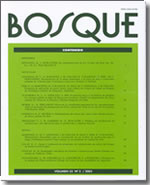Ver ítem
- xmlui.general.dspace_homeCentros Regionales y EEAsCentro Regional Patagonia SurEEA Santa CruzArtículos científicosxmlui.ArtifactBrowser.ItemViewer.trail
- Inicio
- Centros Regionales y EEAs
- Centro Regional Patagonia Sur
- EEA Santa Cruz
- Artículos científicos
- Ver ítem
Natural dynamics and thinning response of young lenga [Nothofagus pumilio] trees in secondary forests of Southern Patagonia = Dinámica natural y respuesta al raleo de árboles juveniles de lenga (Nothofagus pumilio) en bosques secundarios en Patagonia Sur
Resumen
For saw-log production, planned thinning in secondary forests may reduce the time to yield products of a desired size and quality. To explore some options, long-term monitoring plots were established in 1996 in two secondary stands of Nothofagus pumilio (19,300 stems ha-1, age 34 years and 18,300 stems ha-1, age 40 years) in Santa Cruz province, Argentina. The study quantified growth responses to different thinning intensities around crop trees in the
[ver mas...]
For saw-log production, planned thinning in secondary forests may reduce the time to yield products of a desired size and quality. To explore some options, long-term monitoring plots were established in 1996 in two secondary stands of Nothofagus pumilio (19,300 stems ha-1, age 34 years and 18,300 stems ha-1, age 40 years) in Santa Cruz province, Argentina. The study quantified growth responses to different thinning intensities around crop trees in the understory stratum of a two-aged stand, and growth dynamics in a natural unthinned stand regenerated by strip clearcutting. For the analysis of natural dynamics, growth, mortality and shift of crown classes of all trees were measured annually during 10 years. For thinning, 1,111 crop trees per hectare were selected. Thinning consisted of four intensities: elimination of one (T1), two (T2) and all (Tt) effective competitors, and a control (Tc). Each treatment was replicated ten times in a split plot design, where the main plots in this two-aged stand were three different levels of canopy covered by the remaining overstory seed trees (0, 12 and 33 %). The stand dynamics among unthinned plots revealed that competition-induced mortality occurred at a mean rate of 680 trees ha-1 year-1 (3.5 % of all trees) and mean growth rate of 7.2 m3 ha-1 year-1. Ten-year results from the thinned plots indicated a significant difference in the growth response of crop trees among treatments; being higher for Tt and T2, and under 12 % canopy cover. Thinning also reduced windthrow because it removed only the effective competitors and maintained a high stocking among crop trees. That offered mutual protection within the understory stratum.
[Cerrar]
Para producir trozas aserrables, los raleos planificados en bosques secundarios podrían reducir el tiempo requerido para obtener
productos de tamaño y calidad deseados para la industria. En este sentido, en 1996 fueron establecidas parcelas permanentes en dos
rodales coetáneos de Nothofagus pumilio (19.300 árboles ha-1, edad 34 años y 18.300 árboles ha-1, edad 40 años) en la provincia de
Santa Cruz, Argentina. El objetivo del presente estudio fue
[ver mas...]
Para producir trozas aserrables, los raleos planificados en bosques secundarios podrían reducir el tiempo requerido para obtener
productos de tamaño y calidad deseados para la industria. En este sentido, en 1996 fueron establecidas parcelas permanentes en dos
rodales coetáneos de Nothofagus pumilio (19.300 árboles ha-1, edad 34 años y 18.300 árboles ha-1, edad 40 años) en la provincia de
Santa Cruz, Argentina. El objetivo del presente estudio fue cuantificar el crecimiento en respuesta a diferentes raleos en el estrato
juvenil inferior de rodales de dos clases de edad, y compararlos con el crecimiento de rodales bajo dinámica natural regenerados a
partir de tala rasa en fajas. Para el análisis de la dinámica natural, anualmente se midió crecimiento, mortalidad y tasa de pasaje de
clases de copa de todos los árboles durante 10 años. En las parcelas de raleo fueron seleccionados 1.111 árboles futuros por hectárea.
Fueron consideradas cuatro intensidades de raleo: eliminación de un (T1), dos (T2) y todos (Tt) los competidores efectivos de los
árboles seleccionados, y un control. Cada tratamiento fue replicado diez veces en diseño de parcelas divididas (parcelas principales:
tres niveles de cobertura del dosel superior de árboles semilleros; 0, 12 y 33 %). Con dinámica natural, la mortalidad por competencia
ocurrió a una tasa media de 680 árboles ha-1 año-1 (3,5 % del total de árboles) con crecimiento medio de 7,2 m3
ha-1 año-1. Los resultados
luego de diez años, con raleo, indicaron diferencias significativas en el crecimiento entre tratamientos: mayor en Tt y T2 bajo 12 %
de cobertura de copas. Los raleos de baja intensidad redujeron caída de árboles por viento, porque solo eliminaron competidores
efectivos, lo cual mantuvo alta densidad del rodal que protegió a los árboles seleccionados.
[Cerrar]

Autor
Peri, Pablo Luis;
Martínez Pastur, Guillermo José;
Monelos, Lucas H.;
Fuente
Bosque [Valdivia] 34 (3) : 273-279. (2013)
Fecha
2013
ISSN
0717-9200
Formato
pdf
Tipo de documento
artículo
Palabras Claves
Derechos de acceso
Abierto
 Excepto donde se diga explicitamente, este item se publica bajo la siguiente descripción: Creative Commons Attribution-NonCommercial-ShareAlike 2.5 Unported (CC BY-NC-SA 2.5)
Excepto donde se diga explicitamente, este item se publica bajo la siguiente descripción: Creative Commons Attribution-NonCommercial-ShareAlike 2.5 Unported (CC BY-NC-SA 2.5)


